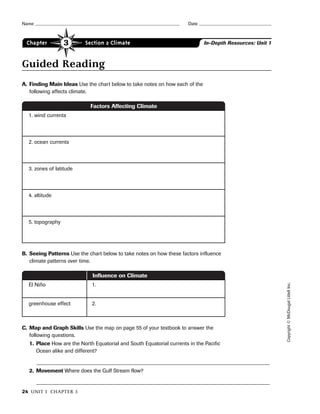More Related Content
Similar to Ch. 3 section 2 worksheet
Similar to Ch. 3 section 2 worksheet (20)
Ch. 3 section 2 worksheet
- 1. Copyright©McDougalLittellInc.
Chapter Section 2 Climate In-Depth Resources: Unit 13
24 UNIT 1 CHAPTER 3
Name Date
Guided Reading
A. Finding Main Ideas Use the chart below to take notes on how each of the
following affects climate.
B. Seeing Patterns Use the chart below to take notes on how these factors influence
climate patterns over time.
C. Map and Graph Skills Use the map on page 55 of your textbook to answer the
following questions.
1. Place How are the North Equatorial and South Equatorial currents in the Pacific
Ocean alike and different?
_____________________________________________________________________________________
2. Movement Where does the Gulf Stream flow?
_____________________________________________________________________________________
1. wind currents
2. ocean currents
3. zones of latitude
4. altitude
5. topography
Factors Affecting Climate
El Niño 1.
greenhouse effect 2.
Influence on Climate
wga-IDR0103.p23-34 1/4/2002 1:21 PM Page 24
- 2. Copyright©McDougalLittellInc.
Chapter Section 2 Climate In-Depth Resources: Unit 13
32 UNIT 1 CHAPTER 3
Name Date
Reading Comprehension Find the missing word or phrase that best completes each
of the sentences below. Write your answers in the blank.
1. Four major factors influence the climate of a region: ____________________,
____________________, ____________________, and ____________________.
2. Wind and ocean currents help distribute the sun’s heat from one part of the world
to another through ____________________, the transfer of heat in the atmosphere
by upward motion of the air.
3. ____________________ are like rivers flowing in the ocean. Moving in large
circular systems, ____________________ flows away from the equator out toward
the poles, and ____________________ flows back toward the equator. They not
only affect the temperature of an area, but they affect the precipitation as well.
4. Geographers divide the earth into three general zones of latitude: lower or
____________________, middle or ____________________, and high or
____________________. Lands in ____________________ zones are hot all year
long. Lands in ____________________ zones are cold all year long. Lands in
____________________ zones have climates that can vary greatly from relatively
hot to relatively cold.
5. Another factor in determining the climate of a region is ____________________, or
distance above sea level. As the distance above sea level increases, the air
temperature ____________________.
6. Topography also affects climate. For example, as moisture-laden winds move up
the side of a mountain they ____________________ and lose their ability to hold
____________________. By the time the winds reach the other side of the
mountain, they are dry and become ____________________ as they flow down the
mountain.
7. Climate changes over time. The warming of water off the west coast of South
America, known as ____________________, is a natural change in the climate.
8. Some scientists argue that global temperature increases are caused by the
____________________, the layer of gases released by the burning of coal and
petroleum that traps solar energy, causing higher temperatures.
Reteaching Activity
wga-IDR0103.p23-34 1/4/2002 1:21 PM Page 32

